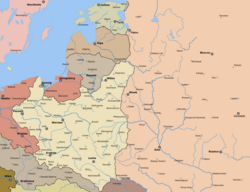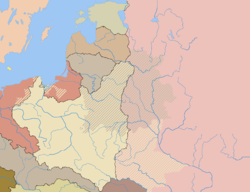| Revision as of 05:31, 16 April 2006 editPiotrus (talk | contribs)Autopatrolled, Event coordinators, Extended confirmed users, File movers, Pending changes reviewers, Rollbackers286,166 edits →The treaty: one more date (from main PSW article)← Previous edit | Revision as of 14:52, 16 April 2006 edit undoPiotrus (talk | contribs)Autopatrolled, Event coordinators, Extended confirmed users, File movers, Pending changes reviewers, Rollbackers286,166 edits →The treaty: add info from main articleNext edit → | ||
| Line 10: | Line 10: | ||
| == The treaty == | == The treaty == | ||
| The peace talks were started on ] ], in ], but after an incident directed against the Polish negotiators, the talks were moved to Riga, and resumed on ]. ] was signed on ]. and went into effect on ]. | The peace talks were started on ] ], in ], but after an incident directed against the Polish negotiators, the talks were moved to Riga, and resumed on ]. In September in Riga the Soviets made two offers: on September 21st and 28th. Polish delegation made a counteroffer on the 2nd of October. On the 5th the Soviets offered amendments to the Polish offer. Poland accepted. ] was signed on ]. and went into effect on ]. | ||
| The chief negotiators were ] for Poland, and ] for the Soviets. | The chief negotiators were ] for Poland, and ] for the Soviets. | ||
Revision as of 14:52, 16 April 2006
| Borders of Poland | |
|---|---|

- See also Riga Peace Treaty for other treaties concluded in Riga.
The Peace of Riga (also known as the Treaty of Riga, Polish: Traktat Ryski) signed in Riga on 18 March 1921, between Poland on one side, and Soviet Russia and Soviet Ukraine on the other, ended the Polish-Bolshevik War.
Background
Further information: Polish-Soviet WarAmidst the Russian Civil War the Poles were eager to regain all the territories of the Polish-Lithuanian Commonwealth from their historical enemy, Russia. Meanwhile, the Soviets tried to export their revolution to the West, by force if necessary. If the Bolsheviks had occupied Poland they would have been in a position to come to the aid of German Communists, and possibly ensure the success of a Soviet revolution in Germany. The historian J.F.C. Fuller described the Battle of Warsaw as one of the most significant battles ever. After that battle, when Poland turned a looming defeat into a great victory, Soviets were eager to sign a peace treaty.
The treaty
The peace talks were started on August 17 1920, in Minsk, but after an incident directed against the Polish negotiators, the talks were moved to Riga, and resumed on September 21. In September in Riga the Soviets made two offers: on September 21st and 28th. Polish delegation made a counteroffer on the 2nd of October. On the 5th the Soviets offered amendments to the Polish offer. Poland accepted. Armistice was signed on October 12. and went into effect on October 18.
The chief negotiators were Jan Dąbski for Poland, and Adolph Joffe for the Soviets.
The Treaty of Riga was controversial from the very beginning. Many argued that much of what Poland had won during the Polish-Bolshevik War, was lost in the peace negotiations that were characterized by many, as short-sighted and narrow-minded. They were lacking what brought Poland independence: Józef Piłsudski's combination of far-reaching predictions, and understanding, with his soul and body of a fighter; also, his integrity. By 1921, Piłsudski was not the head of state, and only participated as an observer during the Riga negotiations, which he called an act of cowardice (Davies, 1972, p.399). Due to their military setbacks, the Bolsheviks offered the Polish peace delegation substantial territorial concessions in the contested border areas. However, to many observers it looked like the Polish side was conducting the Riga talks as if Poland had not won, but lost the war. The exhausted Poles, pressured by the League of Nations, decided to sign the Peace of Riga on March 18, 1921, splitting the disputed territories in Belarus and Ukraine, between Poland and Russia.
The Ukrainians led by Symon Petliura had been fighting shoulder-to-shoulder with Poles, but in Riga the Soviet negotiators were able to talk Poles into 'betraying' them — to the peril of both Poles and Ukrainians. Piłsudski felt the agreement was a shameless and short-sighted political calculation. Allegedly, having walked out of the room, he told the Ukrainians waiting there for the results of the Riga Conference: "Gentlemen, I deeply apologize to you".
The treaty violated Poland's military alliance with Ukraine, which had explicitly prohibited a separate peace. It worsened relations between Poland and its Ukrainian minority, who felt Ukraine had been betrayed by its Polish ally, a feeling that would be exploited by Soviet propaganda and result in the growing tensions and eventual violence in the 1930s and 1940s. By the end of 1921, the majority of Ukrainian, Belarusian and White Russian forces had either crossed the Polish border and laid down their arms or had been annihilated by the Soviets.
However, Józef Piłsudski's dream of creating an Eastern Europe alliance (Międzymorze) of independent countries was thwarted by this treaty, as Poland was unable to fulfill the obligations of its alliance with Ukraine and support its independence, and Polish-Lithuanian relations deteriorated as well as a result of Poland's annexation of the city of Vilnius, which the Lithuanians claimed as their capital.


On the other hand, the Treaty of Riga led to the stabilization of the eastern border of Poland. The new Polish state surrendered most of land lost in 1st and 2nd partition to Russia by the Polish-Lithuanian Commonwealth during partitions of Poland, with a sizeable Polish minority (less than 1 million) especially around Słuck and Żytomierz. This would allow Soviets to carry out harsh reprisals against those Poles - begun with confiscation immense property (land, forests), persecution of religion (bishop Cieplak 1923) and eventually full scale deportation of Poles to Kazakhstan 1931-1934. Population living on the Polish side of the Riga border, including Poles and (approx. 6 million citizens) minorities of Ukrainians, Belarusians, Lithuanians and Jews were largely spared from communist dictatorship, and guaranteed freedom of property and religious faith - for the next 17 years until 1938. However, this didn't protect them from ethnic conflicts, especially during the Great Depression from 1929 on.
Poland also was to receive monetary compensation (30 million rubles) for its economic input into the Russian Empire during the times of partitions of Poland. Russians were also to surrender arts and other Polish national treasures pillaged after 1772 (like the Załuski Library). Both sides renounced claims to war compensation.
External links
- Photocopies of the treaty: pages 1-8, pages 9-16, pages 17-23, appendices and additional protocol
See also
References
- Davies, Norman, White Eagle, Red Star: the Polish-Soviet War, 1919-20, Pimlico, 2003, ISBN 0712606947. (First edition: New York, St. Martin's Press, inc., 1972.)
| Polish truces and peace treaties | |||||||||||
|---|---|---|---|---|---|---|---|---|---|---|---|
| Kingdom of Poland | |||||||||||
| Polish–Lithuanian Commonwealth |
| ||||||||||
| Second Polish Republic | |||||||||||